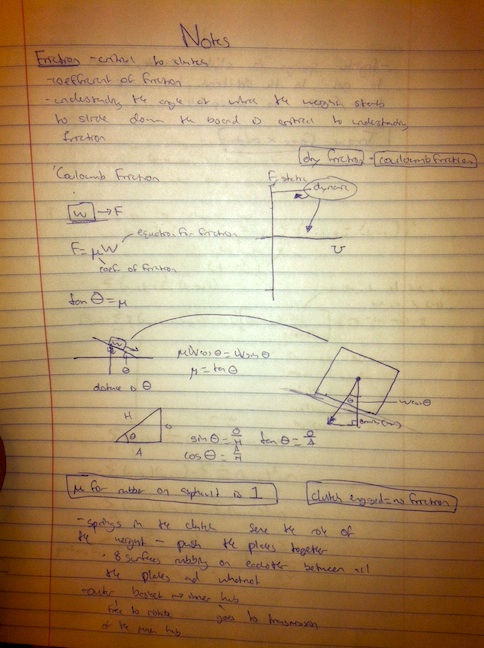Grading
-will be creating presentations on every section of the bike in detail
-participation during class
-workmanship while in the lab
Shop Class Chapter 4 p72-88
From the reading
-Disposition of humans in terms of how they work and respond to what they’re working on
-Certain types of humans are attracted to certain types of work
-Major discussion surrounded the conflict of whether to go to a prestigious school to learn classes you’re not very interested in and get a prestigious degree, or to go to a school where you can learn, specifically, what you love and have a passion for
-The irony is that the author got his Ph.D. from Chicago and hated his job.
New Key Ideas
Transaxle-The part in a car where the axle contains the differential
Spindle Carrier-The casing for needle bearings
Ball Bearings-Apparatus to allow proper movement of shafts and wheels-Contains an outer race, an inner race and a shaft that goes through the inner race.
Match Porting-Matching the openings of two separate parts (intake valve to the cylinder) without proper match porting, causes turbulence and compromises flow of the fuel system.
“Speed Costs Money”-Performance engines that are frankenstein engines of different companies’ parts and people who tweak engines are compromising the health of the engine. Engine designers have functions in mind for certain designs and parts and the use of different parts from other makes can ruin the engine and force the engine to fail.
Force equals mass times acceleration-By decreasing the mass in the flywheel, you can gain acceleration, however the engine won’t run as smoothly
“Heavy Clutch”-With a heavy clutch(tighter tension between the friction plates) can allow you to “ask a lot” from you engine. There won’t be as much slippage with high torque. However, in the case of engine failure, the real wheels can lock up.
Thursday Feb. 28th
Education of a Gearhead:
Major Motorcycle Ideas to Consider:
Matchpotrting-defined above
Galling on the cam lobed-wearing away of material from rubbing(happens with tighter springs on the valves, cause high friction on the cam lobes, can throw off timing)
Journal-Part of the shaft in contact with the bearings
Titanium Nitride-Coats the journal, or any part, to increase the hardness of the metal and improve performance. Can be applied to piston heads.
Stochastic Art-Surgeons and Mechanics (different from builders and designers) They improve and fix things. Builders and Designers build things from scratch for an intended purpose
Objectivity (How it is) vs. Subjectivity (How you imagine it is, how it should be) In terms of level of detail
We saw the example of drawing upside down-Artists are more likely to draw an image more properly upside down because it is more objective.
Measuring the spring constant-In Shop Class as Soulcraft, the author uses a bathroom scale and a vice to measure the springs. Springs that are too stiff will cause the the lobes to gall and parts to mushroom with the increased friction and pressure. Stiffer springs improve the engines efficiency when working at higher RPM.
Friction and Clutch Plates.
The use of larger clutch plates versus more plates. Larger plates increase surface area for more friction and so do more plates. (the triumph uses a basket clutch)
Plates rub against each other to produce friction. 4-8 foot pounds is good slip.
